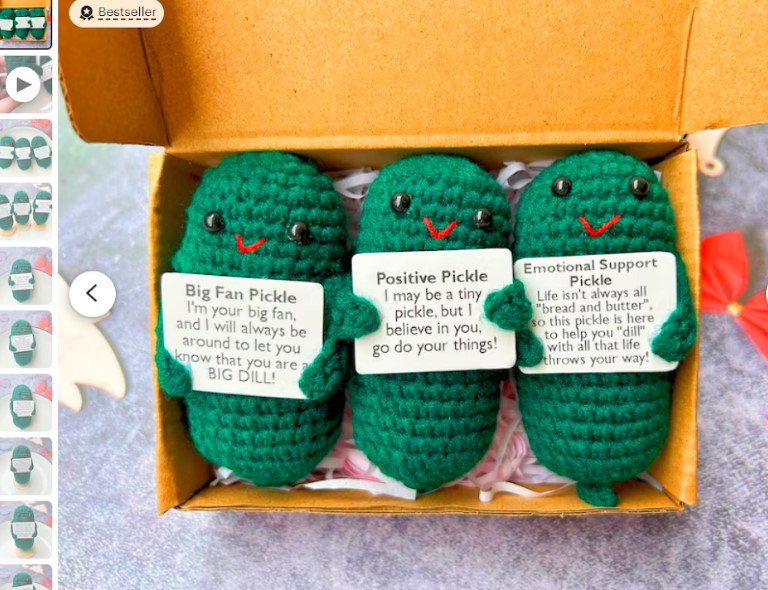18 Smart Marketing Strategies for Handmade Businesses
You decided to sell your handmade products online.
You picked a niche and came up with one-of-a-kind products.
Now what?
How do you find customers for your handmade items?
That’s where marketing comes into the picture, giving your craft the recognition it truly deserves.
Remember, a good product is only half the picture. You must promote it to the right audience to make sales and profits.
In this article, let’s cover the 18 best ways to promote your handmade or craft business to generate better sales.
If you’re new to selling handmade products and want to learn things from scratch, check out this detailed guide on how to sell handmade products and crafts. It is divided into 2 parts – the first part is about planning your handmade business, and the second one is about execution and getting your first sale.
Let’s now get into our topic…
Here are 18 ways to market your craft business.
1. Social Media Presence
Social media is a powerful tool for marketing your craft business, as it allows you to connect with your audience, showcase your products, and drive traffic to your products. Today, many sellers use social media platforms to grow their sales.
You can use platforms like TikTok, Instagram, Pinterest, Facebook, or YouTube to share your story, post behind-the-scenes photos and videos, offer tips and tutorials, run contests and giveaways, and interact with your followers.
You can also use social media ads to target specific audiences and increase your reach. More about that later.
2. Know Your Customer
Understanding the target customer persona is crucial for any business. It helps you learn about their interests, preferences, and pain points. This helps you create products that address their needs and delight them with your designs.
Once you entice a customer, they will likely visit your brand for their future needs. This way, you make a loyal customer. You can use tools like feedback forms, online data resources, analytics, and social media to learn more about your customers’ demographics, psychographics, behavior, and feedback.
3. Have Your Own Website
This step depends on your business goal. Let’s say you want to consider your handmade or craft business as a side hustle or a hobby, you can create a social media presence and drive traffic to your products, run ads, or more.
However, if you are serious about your handmade business, i.e., you want to create a 7-figure business out of it, you should consider building your own website.
Let me make it clear. You have two important benefits of building your website: Customer data and loyalty.
These two are crucial for a business because they help reduce customer acquisition costs.
Gaining a new customer can cost 5-7 times more than retaining existing ones.
Moreover, using a website, you can showcase your products, tell your story, and build trust with your customers. You get better control over your pricing and customer service. You can use platforms like WordPress, Shopify, or Squarespace to create your own website easily and affordably. Also, ensure your handmade business name resonates with your offerings/customers.
In case you need help with showcasing your products or telling your brand story on your website, I can help! Write to me at info@coffeesprints.com or fill out the form, and one of my team members will get back to you.
4. Focus on SEO
If you’re new to SEO, it stands for Search Engine Optimization. It is the process of improving your website’s or product’s visibility and ranking on search engines like Google or Bing and selling platforms like Etsy or Amazon.
SEO helps you attract more organic traffic, which means you’ll be visible to more potential customers who are looking for what you offer. To optimize your product’s SEO, you need to do keyword research, create relevant and engaging content, use descriptive titles and meta tags, optimize your images and videos, and build links from other reputable websites.
You should also factor in customer search behavior to write your product description.
5. Ace Product Photography
Product photography helps you stand out from the competition and attract more attention from potential customers.
When you’re selling a product online, your customers can’t touch and feel your product. The only experience they get is by looking at your product photos and reading the description you wrote about it. That’s why product photography is a crucial aspect of marketing your craft business.

(Source: Etsy)
Showcase the quality, features, and benefits of your products. Give a 360-degree view of your product. If required, get a professional photographer to take your product images. Use a good camera or smartphone, a tripod or a stable surface, natural or artificial lighting, a plain or creative background, and props or accessories that enhance your products.
Also, do ensure that your product images comply with the specifications and requirements of the marketplace that you’re selling in.
6. Increase AOV Through Upselling and Cross-selling
Upselling and cross-selling are techniques that help you increase the average order value (AOV) of your handmade business by offering additional or complementary products to your customers.
As part of the Upselling technique, encourage your customers to buy a higher-priced or upgraded version of the product they are interested in.
Let’s say you run a handmade jewelry business, and a customer is browsing through a selection of necklaces on your website. If they are considering a basic necklace made with semi-precious stones, you can showcase an upsell by suggesting a similar necklace with higher-quality gemstones. Entice them with click-worthy images and detailed description that adds value to them.
Second, Cross-selling means suggesting other products that go well with the product they are buying.
For example, you can cross-sell by recommending a matching handmade necklace that goes with the earrings that your customers want to purchase.
7. Run Paid Ads on Social Media and Google
Paid ads are another way to market your craft business effectively and reach more potential customers. You can run paid ads on social media platforms like Facebook, Instagram, Pinterest, Twitter, or YouTube to target specific audiences based on their interests, demographics, location, behavior, and more.
You can also run paid ads on Google to show up at the top of the search results when people search for keywords related to your products or niche.
8. Sell on Multiple Channels
If you launched your products on one platform, consider expanding them to other selling channels like online marketplaces, social media, your website, or physical stores. Selling on multiple channels can help you reach more customers, increase your brand awareness, and diversify your income streams.
However, selling on multiple channels also requires more time, effort, and resources to manage your inventory, orders, and customer service. So, plan your channels as per your business goals and revenue potential.
9. Build a Mailing List
Building a mailing list means collecting the email addresses of your potential and existing customers who have given you permission to contact them. Building a mailing list can help you communicate with your customers directly, build trust and loyalty, and increase your sales.
You can use email marketing tools like Mailchimp or Mailerlite to create and send newsletters, promotions, updates, and tips to your subscribers. You can also use incentives like discounts, freebies, or contests to encourage people to sign up for your mailing list.
10. Consistent Communication and Standardization
Use the same tone, style, and message across all your marketing channels and platforms. Consistent communication and standardization help you create a strong brand identity, increase customer trust and loyalty, and reduce confusion or misunderstanding.
To achieve consistency, we’d suggest you create a brand guideline and a content calendar and proofread your content before publishing.
11. Offer Unique and High-Quality Products
Do you know 71% of consumers are willing to pay a higher price for better quality products?
E-commerce is a highly competitive niche, and a high-quality product sets your craft business apart. Offer well-made, durable, and functional items to your customers. You can attract more customers who value craftsmanship and authenticity.
12. Build Connections
In a world where machines can do anything, the one thing that is holding and strengthening handmade and craftsmanship is the community.
Often, artists of different backgrounds come together to cultivate a strong sense of community. Be part of a community of like-minded people, build connections, learn and collaborate with them, and gain access to new opportunities. You can join online or offline communities, forums, groups, or networks related to your craft.
Also, attend events, workshops, webinars, or podcasts hosted by experts or influencers in your field. You can also reach out to other crafters or sellers who share your interests or goals.
13. Attend Trade Shows
Attending trade shows means participating in events where you can showcase your products to a large audience, B2B buyers, retailers, distributors, or media. Attending trade shows can help you gain exposure, feedback, and sales for your craft business.
You can also network with other exhibitors or attendees who might be interested in your products or services. But keep in mind, attending these events costs you money. You need to pay for registration fees, travel expenses, booth design, and marketing materials. So plan ahead and prepare well for trade shows to make the most of them.
14. Localize Your Products and Marketing Content
We discussed standardizing your communication earlier. Let’s now delve into the localization.
People across the world like handmade items. Before you expand your craft to various parts of the country/world, you must tweak your marketing communication to fit local needs.
Why, you ask?
To attract more customers, increase customer satisfaction, and make them relate to your products, tailor your content to your target audience’s needs, language, and preferences. To achieve this, you can conduct market research, hire local experts or translators, and test your products or content before launching in the new marketplaces.
15. Run Deals and Discounts
When done right, running coupons, deals, and discounts can effectively increase your sales. They help you attract more customers, clear out excess inventory, and increase your revenue.
For example, you can offer a discount to your new customers. This would help you convert them in the first place and increase your chances of turning them into repeat customers. You can also use holidays, seasons, or special occasions to run deals and discounts.
16. Leverage UGC
UGC (User Generated Content) is a powerful and authentic marketing tool to promote your products. They can be anything – an unboxing video on TikTok, a review on Google, a testimonial, a tweet or post on social media, etc.
UGC can influence potential customer decisions and turn existing ones into brand loyalists. It can also help you build trust and credibility with potential customers who read the content created by your customers before buying from you.
If your customers are happy with their experience, ask them to share their opinions or feedback about your products. Also, customer reviews can help you improve your products based on their suggestions or complaints.
17. Influencer Marketing
If you’re on the fence about working with influencers, think again! Influencer marketing is one of the effective ways to promote handmade items. Collaborating with influential people who have a decent, engaged, and relevant audience on their social media or other platforms will help you increase your sales and credibility.
It’s a win-win because you can offer them incentives, such as free products, discounts, or commissions, and get the spotlight for your products. So find and work with influencers who are relevant to your niche, share your values, and have a genuine interest in your craft.
18. Word-of-mouth Marketing
When your customers get a positive and delightful experience, you can ask them to spread positive word-of-mouth about your products to their friends, family, or other people.
Word-of-mouth marketing can help you generate more referrals, reviews, and testimonials, which can increase your brand awareness, reputation, and conversions.
The best part? It doesn’t break the bank!
Stimulate word-of-mouth marketing by delivering excellent customer service, creating a referral program, soliciting feedback, and rewarding your loyal customers.
Wrapping it up!
Running your business consumes a significant chunk of your time, from creating the product to handling customer service. To make it work, you must determine marketing priorities and allocate resources effectively. Crafting a marketing plan is the key to running your business smoothly.
In case you need help strategizing your marketing or creating content that actually works, feel free to reach out through this form — I’d love to help.






